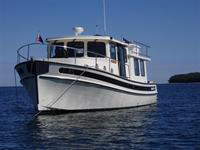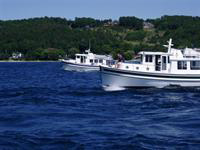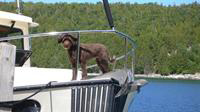In Search of a Pilothouse -

By George T. Wilson
(originally published in PassageMaker Magazine)

Our
40’ Ocean Alexander Sedan was cruising at about 9 knots, transiting a notorious
section of Lake Michigan known as Grey’s Reef, when the weather started
deteriorating, with lightning flashing wildly on the horizon. As a former Coast
Guardsman with a great deal of heavy weather experience, I knew how to prepare,
but this front really had my attention. My wife, Mary Jo, arrived at the helm
with our life jackets when the squall hit us with full force. Steering our bow
slightly off the wind, Jenny Jo’s 28,000 pounds almost immediately rolled over
onto a 30-degree wind list…very dangerous stuff. Violent seas built within
minutes. As visibility fell to near zero, I watched compass headings and how
the helm was responding. The wind was at 60 knots, gusting higher, and we were
rapidly running out of deep water as we made our way toward the reef, taking
boarding seas. To say the least, I was uncomfortable with our limited options.
Just as Mary Jo put her hand on my shoulder and shouted some reassuring words
above the screaming wind, conditions began to improve. It had been the worst
series of squall lines we’d experienced in over 40 years of running big boats.
They were frightening but nevertheless only squalls…squalls that blew through
in a little over 20 minutes.
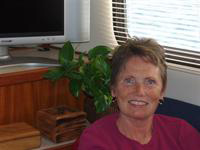
Relief filled the cabin as we started mopping up the water that the wind had driven through the top of the helm door. The lack of space and visiblity around the helm had troubled me. It wasn’t the first time I’d wished for a pilothouse with the superior handling characteristics of a deep- keeled single screw design with a large centerline rudder. As a delivery captain, I’d experienced that type of vessel on several occasions and consider it the best choice. At that moment the final decision was made, we would try to find a pilothouse.
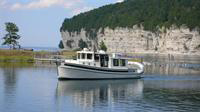
A
couple of days later, we were cruising along the beautiful rocky bluffs of Door
County, Wisconsin on our final leg home to Sturgeon Bay. I was on the bridge,
but learned later that day my wonderful first mate was shedding some tears in
the galley down below. It would not be easy to part with this beautiful, award
winning boat that we’d put our heart and soul into restoring. (“Elusive Dream”
PMM April 2000) The other challenge was to get the appropriate return on our
investment, which substantially exceeded published market values. What we
didn’t fully anticipate was the exposure that PMM has to the world of serious
mariners. Within 30 days of our first ad, we fielded over 50 serious calls and
had two couples fly in from the East Coast, with a third driving up from
Chicago. They had all arrived with our feature stories on the boat in a folder…
they were pre-sold. Three pending sales at full price, one of which was
finalized, and the new owners were thrilled. After removing our custom name
boards, they renamed their boat and were off on the Great Loop.
So, that winter the hunt was on. We
figured in a tough market we could search coast to coast and come up with some
great options. It turned out that anything remotely affordable was going to be
very hard to find. It seems that owners of the best boats don’t sell very
often, and when they do, the price is high and the sale is quick. As with most
veteran cruisers we had some absolute requirements. We wanted a rugged, high quality,
traditional style pilothouse design between 35 and 40 feet. Anything over 40
feet is difficult to handle and maintain when you do most of your own work. And
larger boats don’t allow you to get safely into some of the most spectacular
little hurricane holes in the wilderness…usually, some of our favorite spots.
We would only consider single screw diesel power; and we wanted simplicity of
systems with excellent access, storage, and visibility from the pilothouse. The
hull would have to be full or semi-displacement and we really wanted a fresh
water boat. Our experience with the Ocean Alexander taught us that removing the
results of salt water and salt air from a vessel is close to impossible. The
next summer arrived and it appeared we were going to be without a boat, not a
pleasant thought.
Out of the blue I was offered an Assistant Harbor Master position at a wonderful marina in Fish Creek, Wisconsin. Some of you may be aware of the world-class vacation land that is Door County, Wisconsin. The Alibi Dock Marina is in the heart of the beauty. With more waterfront than any other county in America, if you have to be land locked, this is a great place to be…so, I took the job. I figured it would be fun working around all of the boats for a season, while we continued our search in earnest. Working with Harbor Master Marsha and interacting with all of the long rangers that passed through our port turned out to be lots of fun. Krogens, Nordhavns, Selenes, Nordic Tugs, and the transient list went on. I listened very carefully to what these experienced people had to say about their boats, pro and con. So many great conversations boosted my desire to get back out on the water.
Amazingly,
one year somehow turned into five! I had all but given up on finding a fresh
water boat. Unfortunately and surprisingly, the vast majority of fresh water
powerboats found on the Great Lakes are not appropriate for any kind of serious
cruising, and of no interest to us. Unstable and inefficient, the market was,
and remains flooded with unsold examples at rock bottom prices.
We finally found two nice boats in New
England, but they were sold before we could get on a plane to go see them. The
market value of high quality boats in our size range remains stable, and they
were selling quickly.
After about three years at the marina we had decided on the 37’ Nordic Tug. Two of them had passed through during those years and Mary Jo and I both loved the functional layout. The owner’s enthusiasm, which was off the charts, further fueled our interest. I’d delivered Krogens, and we had friends with Nordhavns, but for what we wanted to do we kept coming back to this one Nordic Tug model that had almost everything we wanted in a boat, and although expensive, they were considerably less than the open ocean voyagers. Nordhavns and Krogens, as terrific as they are, have become very complex, and most had fly bridges, creating lots of canvas and dual electronics, with a long list of extras and options. In our opinion many of these boats are too cluttered up with systems on top of systems that simply aren’t necessary. When it comes to technology and state-of-the-art sophisticated systems, we believe that less really is more. Too many of the new boats insulate you from the experience that brought us out on the water in the first place. Real adventure, basic navigation, feeling and enjoying offshore waters. We wanted a very simple, functional, but high quality boat, preferably over built by production boat standards. Also, for gunkholing the Great Lakes, we like the Nordic’s deep keel semi-displacement hull. You can run comfortably without active stabilizers and you have the option of just a bit more speed when needed to handle the steep short seas found on these Great Lakes. They’re also more stable at anchor with their hard chine, minimizing roll. Of all the Nordic models we feel this is the one with the sweetest running hull and a beautiful sheer line reminiscent of a lobster boat…but how to find one? We seriously considered a new boat the Great Lakes dealer had at a Lake Michigan TrawlerFest event, but decided against it. We wanted the mechanical Cummins and many of the features that had been eliminated from the new boats, so we pressed on.
As we approached 60 years of age I began to wonder if it was just not to be. Maybe our boating days were behind us. In the middle of my fifth season at Alibi, I was in the office preparing for the arrival of a long list of transients that would fill us up for the holiday week ahead, when the radio crackled to life with a request for overnight dockage. I politely advised the lady that we were full, as her vessel appeared around the point outside of our marina. “Are you sure you can’t find a spot for a 37 foot ‘trawler type’ for one night.” Those were the magic words. We always held one slip for emergencies and I felt getting a beautiful 37-foot Nordic Tug in, qualified as an ‘emergency’. The owners, Art and Ronnie, turned out to be delightful and invited me aboard to take a look; of course I was all over it. After an extensive tour, Art commented that I seemed really interested in his boat, so I shared my experience with him, and then he floored me. “My wife and I have been considering selling at the end of this season.” My response was immediate. I asked him to discuss it with her overnight and I would be back in the morning for another look. I didn’t sleep that night and when I greeted them in the morning I heard the words I was so hoping for…they were going to sell. Mary Jo and I went out with them for a two-hour test run in Green Bay the following day. The boat was flawless, and when we returned to the dock I asked my wife what she thought. ”If you don’t buy it your crazy!” That was all it took. Mary Jo loves the water as much as I do, and felt it was now or never. We needed to get back to what we so enjoyed together. The next morning we had a deal. The price was high but fair, and after what we had been through, a few thousand dollars one way or the other no longer mattered. We had found our boat. After a multi year coast to coast search, the right boat just showed up at our own harbor…it was meant to be
Almost
exactly what we’d been searching for, hull number 39 was a 2001 37 that had
never seen salt and enjoyed indoor heated winter storage since new. We arranged
to pick it up in Michigan that fall, after my commitment at Alibi Dock was
fulfilled. The next couple of months were filled with all the anticipation that
so many new boat owners feel…we could hardly wait. Wanting another crewmember,
I called Bud Wheeler; a dear old friend and boating buddy from way back. After
telling him what we had in mind he was on the next plane out of Arizona,
joining us for the maiden voyage home.
The first day went well as all mechanical and electronic systems performed as they should. Day two, however, would be a challenge. Wind was even stronger and small craft warnings went up by dawn, always a troubling sign. We would be dealing with an ever-increasing sea state as we worked our way offshore to the west. Since Bud was new to big water we wanted him to assure us that he was ok with it. As long as I was sure we were within safety limits by my standards, he said he was good to go. He trusted his old friend’s experience and was already confident in this boat, as I was.
Although we’ve had more than our share of operating under small craft warnings, even gales and full storms, it’s never an easy decision to head out in these conditions. The next couple of days were going to be much worse, so we slipped our lines early and cruised into a dark horizon full of building whitecaps. If not for that first day’s run I would not have been confident enough to go in an unfamiliar boat, but I quickly learned that within reason; this was an excellent hull and a wonderful little sea boat. Clearing the protection of Michigan’s bluffs we were finding very rough conditions. Bud was amazed at the whole experience and had found a position, wedged between the pilothouse seat and the chart area that afforded him an exciting view of the wave action. And action there was; being careful not to show my concern to the crew, I was unsure of how well we could hold our course in these large seas quartering off our stern. Those familiar with heavy weather on the Great Lakes fully understand that these are truly inland seas, it’s the real deal when the wind blows out here! We were cruising at about 9 knots, disappearing in the troughs, and in spite of my best effort to stay behind them, occasionally surfing over 16 knots down the front of a rogue wave. I was very busy at the helm watching every wave, keeping my finger near the disengage button on the autopilot just in case. But the autopilot held our course. Designed for the waters of the Pacific Northwest, Lynn Senour had done a marvelous job with this hull. ‘Jenny Jo’ was tracking like she was on rails. The seas had one idea and the large keel and rudder had another, therefore the autopilot wasn’t even breathing hard…very, very impressive. This hull is actually close to 40 feet, with a very low center of gravity and I was rapidly falling in love with the way she handled. Still, it was a comforting sight when we finally spotted the Sturgeon Bay entrance on the horizon, because the seas were building near our safe operating limits. As we surfed into the ship canal we were all smiles…a successful crossing. Entering Sturgeon Bay, some of our cruising friends were awaiting our arrival, with cheers and thumbs up as we passed by their marinas. We were so happy to be back in this wonderful world of camaraderie that we call boating. Working our way up a protected shoreline on Green Bay for a couple of hours, we arrived at Alibi Dock Marina…Jenny Jo’s new homeport.
We
squeezed in a late season run to Fayette Park in Michigan’s Upper Peninsula,
but all too soon it was time to haul out for the season. Several projects were
planned for the winter months ahead. First I would replace the polished
stainless plow with a new Rocna anchor. I also added 200 feet of heavier chain
and replaced the single 8D house battery with four deep cycle 6 volts that
would be easier to handle. The people at Nordic Tug were happy to help with
tips, guidance, and parts. The first big project was replacing all six plastic
ports with the beautiful polished stainless ports that were now standard on the
new tugs. After installing aft spring cleats and waterproof Kayak brackets to
the pilothouse top, I tackled the last really big project of the winter, an
integrated boarding ladder.
With
projects complete, spring launch arrived and our first full season was
underway. Our early cruising had confirmed 3 – 4 NMPG efficiency, and all
of the pleasure we believed a rugged pilothouse like this would bring.
Coincidentally, June brought the first annual Great Lakes Nordic Tug
Rendezvous, where we enjoyed meeting Paul Johnson, Nordics head of production,
who was a fountain of interesting information.
We enjoyed being able to
personally thank him for building these great boats. The instant camaraderie at
this event was really something.
Even Emma, our faithful Portuguese Water Dog made some canine friends. It was a joy from beginning to end…wonderful people
and terrific boats. We had completed an amazing journey; in search of a
pilothouse…and we were thrilled.
